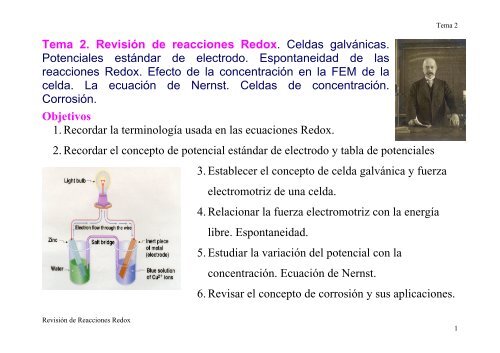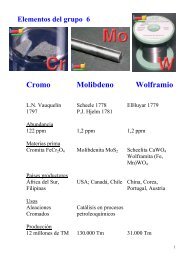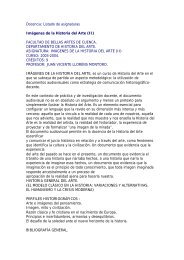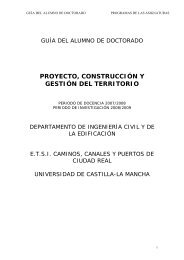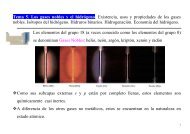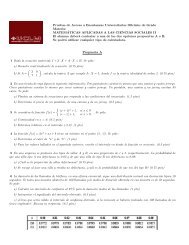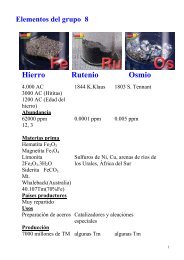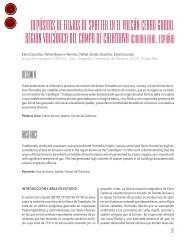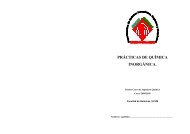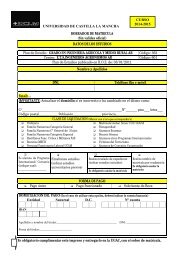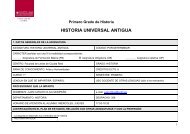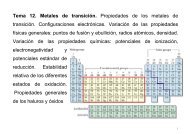Tema 2. Revisión de reacciones Redox. Celdas galvánicas ...
Tema 2. Revisión de reacciones Redox. Celdas galvánicas ...
Tema 2. Revisión de reacciones Redox. Celdas galvánicas ...
Create successful ePaper yourself
Turn your PDF publications into a flip-book with our unique Google optimized e-Paper software.
<strong>Tema</strong> 2<br />
<strong>Tema</strong> <strong>2.</strong> <strong>Revisión</strong> <strong>de</strong> <strong>reacciones</strong> <strong>Redox</strong>. <strong>Celdas</strong> <strong>galvánicas</strong>.<br />
Potenciales estándar <strong>de</strong> electrodo. Espontaneidad <strong>de</strong> las<br />
<strong>reacciones</strong> <strong>Redox</strong>. Efecto <strong>de</strong> la concentración en la FEM <strong>de</strong> la<br />
celda. La ecuación <strong>de</strong> Nernst. <strong>Celdas</strong> <strong>de</strong> concentración.<br />
Corrosión.<br />
Objetivos<br />
1. Recordar la terminología usada en las ecuaciones <strong>Redox</strong>.<br />
<strong>2.</strong> Recordar el concepto <strong>de</strong> potencial estándar <strong>de</strong> electrodo y tabla <strong>de</strong> potenciales<br />
3. Establecer el concepto <strong>de</strong> celda galvánica y fuerza<br />
electromotriz <strong>de</strong> una celda.<br />
4. Relacionar la fuerza electromotriz con la energía<br />
libre. Espontaneidad.<br />
5. Estudiar la variación <strong>de</strong>l potencial con la<br />
concentración. Ecuación <strong>de</strong> Nernst.<br />
6. Revisar el concepto <strong>de</strong> corrosión y sus aplicaciones.<br />
<strong>Revisión</strong> <strong>de</strong> Reacciones <strong>Redox</strong><br />
1
<strong>Tema</strong> 2<br />
<strong>Revisión</strong> <strong>de</strong> Reacciones <strong>Redox</strong><br />
2
<strong>Tema</strong> 2<br />
<strong>Revisión</strong> <strong>de</strong> Reacciones <strong>Redox</strong><br />
3
<strong>Tema</strong> 2<br />
<strong>Revisión</strong> <strong>de</strong> Reacciones <strong>Redox</strong><br />
4
<strong>Tema</strong> 2<br />
<strong>Revisión</strong> <strong>de</strong> Reacciones <strong>Redox</strong><br />
5
<strong>Tema</strong> 2<br />
<strong>Revisión</strong> <strong>de</strong> Reacciones <strong>Redox</strong><br />
6
<strong>Tema</strong> 2<br />
<strong>Revisión</strong> <strong>de</strong> Reacciones <strong>Redox</strong><br />
7
<strong>Tema</strong> 2<br />
<strong>Revisión</strong> <strong>de</strong> Reacciones <strong>Redox</strong><br />
8
<strong>Tema</strong> 2<br />
<strong>Revisión</strong> <strong>de</strong> Reacciones <strong>Redox</strong><br />
9
<strong>Tema</strong> 2<br />
<strong>Revisión</strong> <strong>de</strong> Reacciones <strong>Redox</strong><br />
10
<strong>Tema</strong> 2<br />
<<br />
<strong>Revisión</strong> <strong>de</strong> Reacciones <strong>Redox</strong><br />
11
<strong>Tema</strong> 2<br />
Energía eléctrica = volts X coulombs = joules<br />
carga total = nF 1 F = 96 500 C/mol<br />
∆G = W max ∆G = -nFE celda<br />
K =<br />
c<br />
[ C] [ D]<br />
d<br />
[ ]<br />
a<br />
A [ B] b<br />
∆G 0 =-nFEº celda ∆Gº = -RT In K<br />
Entonces -nFEº celda =-RTlnK<br />
Eº =<br />
0,0592V<br />
n<br />
log<br />
K<br />
∆G 0 K Eº celda Reacciones en cond. <strong>de</strong> estado estándar<br />
Negativo > 1 Positivo Espontánea<br />
0 = 1 0 En equilibrio<br />
Positivo < 1 Negativo No espontánea. La reacción es espontánea en<br />
la dirección inversa.<br />
<strong>Revisión</strong> <strong>de</strong> Reacciones <strong>Redox</strong><br />
12
<strong>Tema</strong> 2<br />
<strong>Revisión</strong> <strong>de</strong> Reacciones <strong>Redox</strong><br />
13
<strong>Tema</strong> 2<br />
<strong>Revisión</strong> <strong>de</strong> Reacciones <strong>Redox</strong><br />
14
<strong>Tema</strong> 2<br />
c<br />
aA + bB cC + dD [ C] [ D]<br />
<strong>Revisión</strong> <strong>de</strong> Reacciones <strong>Redox</strong><br />
Q =<br />
d<br />
[ ]<br />
a<br />
A [ B] b<br />
15
<strong>Tema</strong> 2<br />
<strong>Revisión</strong> <strong>de</strong> Reacciones <strong>Redox</strong><br />
16
<strong>Tema</strong> 2<br />
<strong>Revisión</strong> <strong>de</strong> Reacciones <strong>Redox</strong><br />
17
<strong>Tema</strong> 2<br />
0.1M<br />
Eº(Fe +3 /Fe +2 )= 0.77v<br />
Eº(Ag + /Ag) = 0.80v<br />
<strong>Revisión</strong> <strong>de</strong> Reacciones <strong>Redox</strong><br />
18
La corrosión<br />
Corrosión es el término aplicado al <strong>de</strong>terioro <strong>de</strong> metales por<br />
un proceso electroquímico.<br />
• Para que el hierro se oxi<strong>de</strong> es<br />
necesario que estén presentes<br />
el agua y el oxígeno gaseoso.<br />
Una parte <strong>de</strong>l hierro funciona<br />
como ánodo:<br />
<strong>Tema</strong> 2<br />
Fe(s) -- Fe +2 (ac) + 2e<br />
Los electrones liberados reducen<br />
el oxígeno atmosférico a agua en<br />
el cátodo, que es otra parte <strong>de</strong>l<br />
metal:<br />
O 2 (g) + 4H + (ac) + 4e ---- 2H 2 O(l)<br />
La reacción redox global es:<br />
2Fe(s) + O 2 (g) + 4H + (ac) ------ 2Fe +2 (ac) + 2H 2 O(l)<br />
<strong>Revisión</strong> <strong>de</strong> Reacciones <strong>Redox</strong><br />
19
Protección frente la corrosion<br />
<strong>Tema</strong> 2<br />
El recurso más obvio consiste en cubrir la superficie <strong>de</strong>l metal con<br />
pintura.<br />
Pasivación. Se forma una capa <strong>de</strong>lgada <strong>de</strong> óxido cuando se trata al<br />
metal con un agente oxidante fuerte como el ácido nítrico<br />
concentrado.<br />
Mediante aleaciones; la aleación entre el hierro, el cromo y el níquel<br />
para formar el acero inoxidable, la capa <strong>de</strong> óxido <strong>de</strong> cromo que se<br />
forma protege al hierro <strong>de</strong> la<br />
corrosión.<br />
La protección catódica es un<br />
proceso en el cual el metal que va<br />
a ser protegido <strong>de</strong> la corrosión se<br />
convierte en el cátodo <strong>de</strong> una<br />
celda electroquímica<br />
<strong>Revisión</strong> <strong>de</strong> Reacciones <strong>Redox</strong><br />
20
<strong>Tema</strong> 2<br />
<strong>Revisión</strong> <strong>de</strong> Reacciones <strong>Redox</strong><br />
La oxidación <strong>de</strong>l Fe +2 a Fe +3 <strong>de</strong>pen<strong>de</strong> <strong>de</strong>l pH<br />
21


